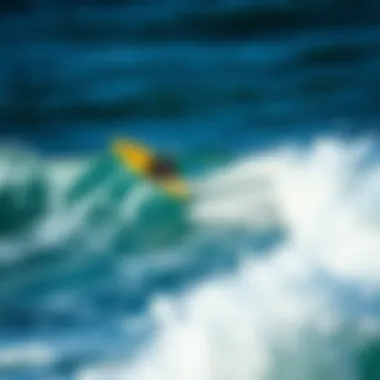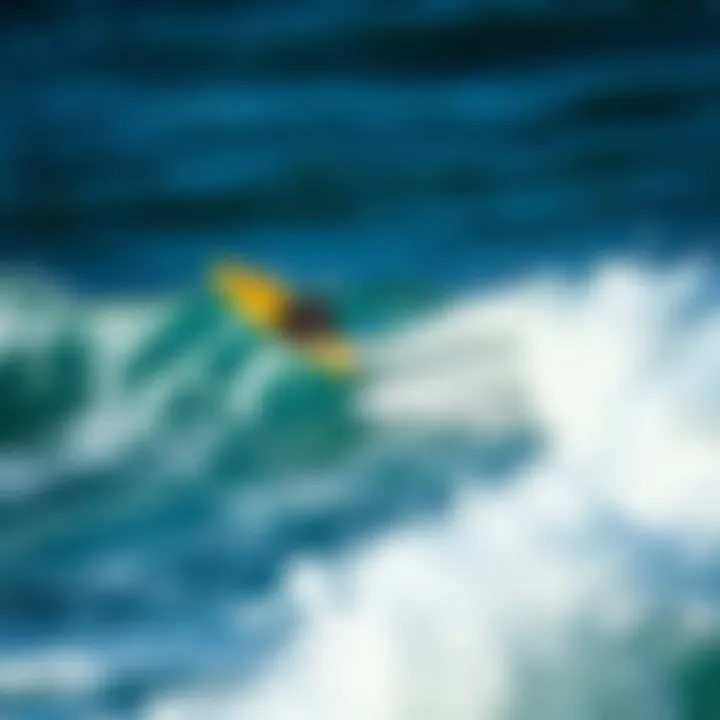The Art of Lift Foil Boarding: A Comprehensive Exploration


Intro
Lift foil boarding, a sport emerging from the intersection of surfing and kitesurfing, has captured the imagination of many water sports enthusiasts. It allows riders to glide above the water, creating an almost otherworldly experience as they rise on a hydrofoil. This sport has seen remarkable growth in recent years, drawing in both novices and seasoned athletes alike. As folks dip their toes into this exhilarating realm, they often find themselves eager to learn about essential gear, key techniques, and the community surrounding lift foil boarding.
As our exploration unfolds, we will delve into gear selection, examining the various types of kites and how to choose the right board to enhance your ride. We will then navigate skill development, highlighting essential techniques and offering progression tips to help you elevate your skills on the water. Throughout this article, we will keep safety in mind, addressing necessary precautions to ensure that everyone enjoys this fantastic sport responsibly. Moreover, we’ll touch upon the environmental considerations that come into play in this captivating water sport, as well as discuss emerging trends that signify the bright future of lift foil boarding.
By the time you’ve read through our exploration, you’ll possess the knowledge and insights that can take your lift foil boarding experience to exhilarating new heights.
Gear Selection
Types of Kites
When it comes to lift foil boarding, the type of kite you choose can significantly influence your experience on the water. The two main categories of kites include the leading edge inflatable (LEI) and the foil kite.
Leading edge inflatables, like the North Rebel or the Ozone Edge, are fantastic for beginners due to their stability and ease of use. They provide solid power and are reliable in various wind conditions. On the other hand, foil kites, such as the Flysurfer Soul, offer a lightweight design beneficial for longer sessions and lighter winds.
The wind conditions you typically ride in will also guide your choice. If you're mostly in gusty conditions with variable wind speeds, an LEI kite might be more forgiving. For smoother, steadier wind, a foil kite could provide you with the efficiency and performance you desire.
Choosing the Right Board
Selecting an appropriate board for lift foil boarding entails considering your weight, skill level, and the conditions you’ll be riding in. Boards come in various sizes and shapes. A larger board may help a beginner with stability, while a smaller board could be tailored for more advanced maneuvers.
For those just starting, look into boards such as the Liquid Force Foil Board or the Slingshot Infinity. Both provide a good balance between stability and performance. As skills improve, transitioning to a smaller, more responsive board like the Naish Hover could facilitate sharper turns and more complex tricks.
"Finding the right board is much like finding the right pair of shoes; it should feel like an extension of yourself."
Ultimately, your choice should reflect where you see yourself heading in the sport. Your board is not just your craft; it's your ally on the water—choose wisely.
Skill Development
Essential Techniques
Getting the hang of lift foil boarding does require some foundational skills. Starting from basic kite control, it's crucial to understand how to maneuver the kite efficiently in the air. Hone your skills by practicing on land before hitting the water.
Once you’ve got kite control down pat, getting comfortable with pumping the foil to generate lift is the next big step. The motion can feel a little tricky at first, as you’ll need to coordinate your body movements with the foil’s glide. It's all about rhythm; once you find your groove, you’ll start to feel that lifting sensation.
Progression Tips
As with any sport, practice is key to progressing your lift foil boarding skills. A few tips to keep in mind:
- Start Small: Begin with shorter sessions to build your comfort and resistance on the foil.
- Ride with Others: Join a local community or find a mentor who can help guide you and challenge your limits.
- Film Yourself: Recording your sessions can help you grasp areas for improvement that you might not notice in real-time.
Learning is an ongoing journey. Engage with the community on platforms such as reddit.com/r/kitesurfing or join groups on facebook.com related to foil boarding to garner tips and share experiences.
By nurturing your techniques and being mindful of your equipment, you can deepen your understanding of this electrifying sport, ensuring a safe and enjoyable ride through the waves.
Preamble to Lift Foil Boarding
Lift foil boarding has rapidly gained traction in water sports, captivating a broad spectrum of enthusiasts from casual riders to adrenaline seekers. This intriguing discipline combines elements of surfing, kiteboarding, and windsurfing while introducing an entirely unique experience—that of gliding above the water. Essentially, lift foil boarding employs a hydrofoil, which lifts the board out of the water, reducing drag and allowing for smoother rides over choppy waves.
Understanding the mechanics and allure of lift foil boarding is essential for both novices and seasoned riders. At its core, this sport represents a convergence of technology, skill, and thrill, appealing to those who appreciate both the serene and extreme aspects of aquatic sports. The dynamics of lift foil boarding also encourage environmental consciousness among practitioners, as many riders gravitate towards locations that celebrate nature and marine ecosystems. The community around lift foil boarding fosters a sense of camaraderie, with riders sharing tips, experiences, and techniques to enhance their time on the water.
The Origins of Lift Foil Boarding
The history of lift foil boarding is a relatively recent one, tracing its roots back to the early 2000s. Its development is often credited to the innovative spirit of designers and water sports enthusiasts who sought to elevate traditional activities. One of the pivotal moments in the evolution of this sport came with the introduction of the first prototypes by visionary craftsmen, like those working with high-tech materials and computer-aided design. This technology has allowed for more efficient, lighter, and responsive foils.
Initially, lift foil boarding might have seemed like a niche hobby, but it delighted early adopters with its novel approach to gliding over water. As technology progressed, so did the exposure of this sport through regional competitions and social media platforms, particularly among adrenaline enthusiasts who sought fresh ways to push their limits.
Understanding the Appeal
The overwhelming allure of lift foil boarding lies in its ability to provide a unique sense of freedom. Riders often describe the first time they take flight on a foil board as nothing short of magical—a blend of exhilaration and tranquility, gliding above the water while being one with nature.
The reasons people are drawn to this sport are varied:
- Innovation: With continuous advancements in technology, lift foil boarding is constantly evolving, making it exciting for tech-savvy enthusiasts.
- Physical Challenge: It demands balance, coordination, and agility, offering an engaging workout that many find rewarding.
- Connection with Nature: Navigating serene coastlines or challenging waves fosters a profound respect for marine environments and local ecosystems.
- Community: From local meetups to global events, the lift foil boarding community is welcoming, sharing knowledge and experiences that enrich the sport for all.
"Foiling transforms the experience of water sports; each ride feels like a dance with the waves."


In sum, lift foil boarding combines the thrill of sport with the joys of the ocean, paving the way for enthusiasts to embrace both challenges and camaraderie. As we dive deeper into the aspects of lift foil boarding throughout this article, it becomes evident that this sport is not merely about riding the waves; it's about cultivating an experience that resonates deeply within each rider.
Equipment Overview
In the realm of lift foil boarding, the right equipment can make or break the experience. Choosing your gear diligently not only enhances performance but also assures safety and comfort while riding the waves. Understanding the components of lift foil boarding gear is essential for both amateurs and seasoned enthusiasts as it aids in assessing which setups align with one’s skill level and riding aspirations.
Types of Lift Foil Boards
Lift foil boards come in various designs, catering to different riding styles and conditions. Generally, they can be categorized into three primary types:
- Surf Foils: These boards are typically shorter and wider, designed for catching smaller waves. They offer increased stability which is essential for riders just starting their journey.
- All-around Foils: As the name implies, these boards serve versatile purposes, making them a popular choice among diverse riders. They balance speed and maneuverability, fitting for varying weather conditions.
- Race Foils: These are longer and narrower, aimed primarily at speed and distance. Professional foil boarders favor these boards when competing or attempting to achieve high speeds.
Understanding the types of lift foil boards helps customers to select a board that fits their personal style and performance needs.
Foil Construction and Design
Materials Used
The construction of lift foils utilizes a blend of materials, each with specific characteristics contributing to their performance. Common materials include:
- Carbon Fiber: Well-known for its lightweight quality, carbon fiber provides exceptional stiffness, making it a popular choice for serious foil boarders. Its ability to handle stress while maintaining a low weight makes it advantageous, especially during high-speed maneuvers.
- Aluminum: A more affordable option, aluminum foils offer durability but may lack the flexibility and performance of carbon counterparts. They are often chosen by novice riders who are still learning the ropes.
The unique attribute of carbon fiber foils is that they typically provide a faster lift and smoother ride compared to those made from aluminum. However, the trade-off is that they come with a heftier price tag.
Size Variations
When it comes to size, lift foil boards typically range in length from 4 to 7 feet, with many options tailored to rider weight and skill level. Different sizes cater to different conditions; shorter boards facilitate easy turns, while longer boards provide stability for cruising around bubbles and uneven waters.
,
Moreover, length impacts lift; longer boards can catch waves at lower speeds but require more effort to steer. A key consideration for novice riders would be to pick a size that offers a balance of both lift and ease of use, steering clear from anyone overly narrow or long if they are still honing their craft.
Performance Features
Performance features heavily influence a board’s user experience, revolving around aspects like lift, efficiency, and stability.
- Lift: Effective lift allows the rider to glide smoothly above water, an attribute that foils like the GONG F-One and Slingshot minimize drag and improve efficiency.
- Stability: Features such as a wider platform enhance stability, appealing to beginners as it reduces the risk of falling.
However, boards that maximize lift often come at the cost of reduced maneuverability, posing a challenge for riders eager to perform tricks or sharp turns. The key is to find a foil board that strikes a balance between lift and control, aligning with the user’s experience.
Necessary Accessories
No lift foil board setup is complete without the right accessories to enhance the riding experience. Essential accessories include:
Wing Selection
The wing selection is critical as it directly affects lift and speed. Riders can choose wings designed for different purposes, from smaller, faster options for advanced tricks to larger wings that promote stability, ideal for beginners. The versatility of wings means that one can adapt their setup based on the type of riding they’re aiming to do, whether it be racing, surfing breaks, or simply gliding around.
Board Attire
Dressing appropriately is another cornerstone of successful lift foil boarding. Wearing suitable board attire such as wetsuits or rash guards can prevent injuries from falling and keep the body warm in cold water. Also, specific materials can provide better mobility and are easier to dry, enhancing the overall experience on the water. For example, a good four-way stretch fabric allows for unrestricted movement while gliding on the board.
Safety Gear
Safety should never take a backseat. Investing in proper safety gear like impact vests, helmets, and leashes can significantly mitigate risks while out on the water. A sturdy helmet will protect against head injuries, and an impact vest can cushion the body in case of falls. These items may seem like extra weight at first, but they are vital, especially for those still mastering the craft.
Always prioritize safety gear when trying out new maneuvers.
At the end of the day, investing in the right equipment and accessories will not only enhance performance but also ensure a safe and enjoyable lift foil boarding experience.
Techniques for Mastering Lift Foil Boarding
In the exhilarating realm of lift foil boarding, mastering essential techniques plays a pivotal role in enhancing both the performance and enjoyment of the sport. The beauty of lift foil boarding lies not just in the thrill but also in the nuances of balancing on water and the mechanics of the foil itself. This section will guide learners through foundational skills, advanced maneuvers, and the critical components of maintaining balance and control while boarding.
Getting Started: Basic Skills
Every rider, regardless of experience, must first establish strong foundational skills in lift foil boarding. This includes learning the proper stance, understanding weight distribution, and getting comfortable with the sensations of gliding above water. The initial phase often involves a lot of trial and error, but this is where significant progress occurs.
- Proper Stance: It’s vital to keep your body aligned over the board while maintaining a slight bend in your knees, allowing for some flexibility.
- Weight Distribution: Shifting your weight forward or backward can greatly influence your speed and elevation.
By starting with these basic skills, riders will set the groundwork for more complex maneuvers.


Advanced Maneuvering Techniques
Once riders feel at ease with the basics, they can venture into advanced techniques that unlock a new level of performance. This area of lift foil boarding requires both confidence and finesse. Advanced maneuvers can significantly improve one’s overall experience, allowing for a greater range of motions and styles.
Turning and Carving
Turning and carving is a crucial aspect of advanced lift foil boarding techniques. This skill allows a rider to maneuver smoothly across the water rather than merely going straight. Riders who master this find themselves making sharp turns with ease, almost like a ballet dancer on water.
- Key Characteristic: The ability to change direction fluidly while maintaining speed and stability is paramount. A good turn not only conserves energy but also enhances overall ride performance.
- Popular Choice: Many riders cite carving as their favorite maneuver because it adds style and grace to performance, making the boarding experience visually appealing for both the rider and observers.
- Unique Feature: A unique element of carving involves employing your hips to guide the board while keeping your upper body stable, creating a seamless flow in movement.
Yet, it’s not without its challenges. Poor technique in turning can lead to loss of control, causing accidents or falls.
Jumping and Tricks
Jumping and tricks define the artistic aspect of lift foil boarding. Riders who push their limits often find joy in experimenting with various tricks, which can range from simple jumps to more complex aerial maneuvers.
- Key Characteristic: A jump typically requires precise timing, with the rider needing to coordinate their body movements with the foil. This challenge appeals to thrill-seekers looking for adrenaline.
- Popular Choice: Tricks captivate many, as they not only demonstrate skill but also create opportunities for expression on the water.
- Unique Feature: The sensation of launching into the air offers a brief moment of weightlessness that many describe as akin to flying.
However, the learning curve is steep. Mistakes can result in hard landings and potential injuries, emphasizing the need for safety practices in conjunction with learning tricks.
Maintaining Balance and Control
Lastly, maintaining balance and control while foiling is foundational to every successful ride. Even the most experienced riders face challenges, especially in shifting weather conditions or unfamiliar waters.
- Key Stability Techniques: Using your core muscles is essential. Engaging these muscles not only aids in balance but also allows for quicker reactions to changing conditions.
- Practice Focus: Concentrating on weight shifts and body posture ensures stability throughout various maneuvers.
In summary, the techniques for mastering lift foil boarding encompass both fundamental skills and advanced maneuvers. These techniques enhance the overall experience, promoting safety, style, and a sense of freedom.
"The art of lift foil boarding not just lies in riding the waves but mastering the dance between water and air."
For further insights and community discussions, check out the Lift Foil community on Reddit.
Also, for safety tips, consider exploring resources from the U.S. Coast Guard.
Mastering lift foil boarding is a journey, and every rider has an adventure waiting for them.
Safety Practices in Lift Foil Boarding
Safety in lift foil boarding is not just a set of rules; it’s the backbone upon which the enjoyment of this exhilarating sport is built. Understanding and implementing safety practices can not only enhance the experience but also ensures that riders can partake in this activity with minimal risks. This section elaborates on why these practices matter and how they contribute to a safer and more enjoyable lift foil boarding experience.
Pre-Ride Safety Checks
Before you even hit the water, conducting thorough pre-ride safety checks is essential. Just like a pilot wouldn’t take off without checking their instruments, a lift foiler should inspect their equipment carefully. Here’s a checklist to consider:
- Board Inspection: Ensure there are no cracks or damaged components. Look at the foot straps and pads, ensuring they are secure and comfortable.
- Foil Setup: Check the foil attachment to the board is tight, and the wing is aligned properly. A misaligned foil can lead to unexpected falls or loss of control.
- Safety Gear: Put on your life jacket or impact vest, along with a helmet if preferred. It can’t be stressed enough that wearing the right gear is vital.
- Environmental Checks: Assess water conditions. Check for wind speed and direction, wave height, and any obstacles in the water. If it’s too windy or choppy, it might be wise to postpone your ride.
A little diligence before launching can save your skin and your gear!
Risk Awareness and Management
Managing risk while lift foil boarding is crucial. Each session brings its unique challenges, and being aware of potential hazards can make all the difference.
- Knowledge of Local Waters: Familiarize yourself with the area you plan to ride. Knowing about currents, tides, and wildlife can help you avoid dangerous situations.
- Buddy System: It’s never a bad idea to ride with a buddy. If something goes wrong, having someone there can be lifesaving. Plus, it makes for a great camaraderie.
- Training: Continuous improvement through training and education helps in understanding more about the dynamics of lift foiling. Enrolling in a course or learning from experienced instructors can equip you with essential skills to handle various situations.
- Recognizing Personal Limits: It’s important to gauge your own comfort level and experience during each session. If conditions feel beyond your capability, it’s perfectly fine to sit it out.
Emergency Procedures
Despite thorough preparations, accidents can happen. Knowing how to handle emergencies can significantly increase safety for both the rider and those around them.
- Immediate Response: If you fall, the first step is to quickly orient yourself and evaluate the situation. Check for other riders nearby and make sure you are not in their path.
- Emergency Signal: Establish a clear signal with your riding partner or group in advance, such as raising an arm. This communicates that you need assistance without needing to shout, allowing for a swift response without causing panic.
- Rescue Plan: Always have a plan in place should someone get in trouble. This could involve notifying a nearby boat or jet ski for help or knowing the closest exit points to shore.
- First Aid Knowledge: Familiarizing yourself with basic first aid procedures, such as treating cuts, abrasions, or sprains can also be beneficial. First aid kits should be readily available at riding spots.
Environmental Considerations
Understanding the environmental factors tied to lift foil boarding is paramount. As this sport gains traction around the globe, its environmental impact is becoming a crucial discussion. Riders must recognize that with every lift and glide above the water, they are not just engaging in thrilling experiences but also interacting with ecosystems that deserve care and preservation.
Impact of Lift Foil Boarding on Ecosystems
Lift foil boarding, while exhilarating, can carbon a significant footprint on aquatic environments. The foils and boards glide through water, creating disturbances that can affect marine life. Disturbances from fast-moving boards can disrupt the habitats of various fish and crustaceans, particularly in shallow waters. For example, for areas with seagrasses, the presence of foil boards might result in the uprooting of these vital plants, which act as nurseries for young fish and as critical food sources for other marine creatures.
Moreover, the noise pollution produced by motorized foil boards can adversely affect wildlife, hindering their communications and breeding. In sensitive ecological zones, such as coral reefs and estuaries, the impact tends to be even more pronounced due to the delicate balance needed to maintain biodiversity. Thus, it's essential for riders to be aware of their surroundings and the potential repercussions of their activities on local wildlife.


"Every action we take on the water echoes in the ecosystems beneath us. It’s our responsibility to ensure that these experiences enhance rather than harm our natural playgrounds."
Best Practices for Sustainable Foiling
To minimize the ecological footprint of lift foil boarding, riders must adopt sustainable practices. This not only enriches the adventure but also promotes the longevity of the sport. Here are several best practices to consider:
- Know the Local Regulations: Before heading out, familiarize yourself with local laws or guidelines regulating foil boarding activities. This can include designated areas for foiling and protected wildlife zones.
- Avoid Sensitive Areas: Steer clear of significant habitats like coral reefs, bird nesting spots, and areas with rich marine biodiversity. If you spot wildlife, give them space and avoid disturbing their environment.
- Practice Responsible Parking: If using a motorized foiling system, anchor responsibly to avoid damaging delicate seafloor habitats. Always look for appropriate places to dock or launch your foil board.
- Educate Yourself and Others: Share knowledge about sustainable practices with fellow riders. Encourage group discussions, and be proactive about advocating for eco-friendly behaviors within the community.
- Participate in Cleanup Efforts: Get involved in local initiatives aimed at protecting and cleaning waterways. By participating, you help ensure the preservation of the environment for future generations of riders.
By blending excitement with responsibility, the lift foil boarding community can thrive while contributing to a healthier planet. Education around environmental challenges allows for informed choices, helping ensure that the beauty of nature remains intact for all to enjoy.
Exploring Popular Locations for Lift Foil Boarding
Finding the perfect spot for lift foil boarding can make or break your experience. The right location not only offers the thrill of gliding above the water but also provides optimal safety, accessibility, and ambiance. When thinking about destinations, it’s essential to consider factors such as the local weather, water conditions, and community presence. Understanding these variables helps ensure that riders, whether novices or veterans, have an unforgettable time on the water.
Top Destinations Around the Globe
There’s no shortage of amazing locations to choose from. Here’s a breakdown of some of the world’s top destinations:
- Maui, Hawaii: Known for its consistent winds and warm waters, Maui is a go-to for many riders. The beautiful landscapes and vibrant ocean life also make it a popular tourist spot.
- Cape Town, South Africa: This is a hub for many water sports, including lift foil boarding. The astonishing mountains and unique wind patterns create an exhilarating experience.
- Gold Coast, Australia: With stunning beaches and perfectly shaped waves, Gold Coast offers a great combination of leisure and adventure.
- Lake Tahoe, California: Ideal for those who prefer flat water conditions. The breathtaking scenery of the Sierra Nevada mountains adds to the charm of this location.
With these locales, you'll find a mix of challenges and supportive communities.
Local Conditions and Their Influence
Local conditions play a crucial role in how enjoyable the lift foil boarding can be. Almost every body of water can offer something unique, but it’s about knowing what to look for:
- Wind Patterns: Consistent winds are vital. Beginners might want to avoid overly windy days, where controlling the board becomes difficult.
- Water Conditions: Flat water is easier for newcomers, while off-shore winds might create more challenging conditions. Turbulent waters can be fun for more experienced riders but can pose risks for those still learning.
- Temperature: Weather impacts not just comfort but safety too. Cold temperatures may necessitate wetsuits, while warm sunny days can enhance the enjoyment.
Remember, knowing the local conditions ahead of time can keep you safe and increase your enjoyment.
In the end, the combination of stunning locations and proper local conditions enhances the lift foil boarding experience, allowing enthusiasts to connect more deeply with the sport and nature. Gear up and pick a spot that speaks to you!
The Future of Lift Foil Boarding
The future of lift foil boarding holds immense potential for transformation within the sport. It is not just about the thrill of gliding over the water; it's also about the innovations and community growth that shape the direction of this captivating activity. As more people discover the joy it brings, understanding the trajectory of lift foil boarding becomes essential. It has already started carving a niche, and there's no sign of it slowing down.
Innovations in Foil Technology
Advancements in technology play a crucial role in elevating the experience of lift foil boarding. Over the past few years, manufacturers have been increasingly adopting lightweight materials such as carbon fiber, which significantly enhances the performance and responsiveness of boards. The latest hydrofoils are designed with precision, allowing for optimized lift and drag reduction.
New developments in battery-operated foil systems are also changing the game. Electric foiling enables riders to experience lift away from traditional windy locations, pushing boundaries further. As the technology gets better, we can expect quieter and more powerful electric units, making it accessible for beginners and experts alike.
Another area of innovation is in the design. Boards are becoming more customizable, catering to individual preferences. Companies are experimenting with various wing shapes, sizes, and angles, ensuring there’s something for everyone at the water's edge. These advancements are designed not only for performance but also for sustainability, utilizing eco-friendly materials and processes, making it a responsible choice for those who love nature.
"The evolution of lift foil technology ensures a dynamic future, blending performance with eco-consciousness, fostering growth in the community."
Expanding Communities and Competitions
Alongside technological advancements, the community surrounding lift foil boarding is expanding at a rapid pace. Clubs and meetups are becoming increasingly popular, where both newbies and seasoned riders can share their passion and skills. These gatherings are essential, as they foster a culture of learning, connecting riders from diverse backgrounds.
Competitions are also gaining traction, with events popping up in coastal towns and cities. These contests not only push participants to hone their skills but also enhance visibility for the sport, drawing in spectators and potential newcomers. The thrill of watching professionals tackle challenges inspires others to give it a go.
Moreover, social media platforms like Instagram and TikTok amplify this community spirit. Riders are able to share their experiences, showcase their skills, and connect with likeminded enthusiasts globally. Hashtags like #LiftFoil and #FoilBoarding are bustling with content, where tips, challenges, and beautiful landscapes come together to create a vibrant tapestry of the foiling life.
As competitions grow, so do educational resources. Workshops, either online or in person, are increasingly considered valuable by participants who are eager to improve. Instructors and experienced riders share their knowledge generously, building a more informed and skilled community.
The End
As we draw the curtain on our journey through the realm of lift foil boarding, it’s clear this sport is more than just a pastime; it’s a dance with the water and wind, an experience that combines freedom with finesse. This conclusion serves to reinforce the significance of the insights provided throughout the article, showcasing not only the art behind lift foil boarding but also the profound community and environmental consciousness that thrives within it.
Recap of Key Insights
The exploration covered various facets of lift foil boarding, beginning with its exciting origins and evolution. We delved into the core equipment, highlighting the intricacies of different board types and the materials that contribute to performance. Notably, the article discussed essential techniques for mastering balance and control and the advanced maneuvers that can elevate a rider's skill level. Safety, of course, has been a recurring theme, emphasizing the importance of pre-ride checks and risk management in a sport that can be unpredictable by nature.
Moreover, we examined the environmental considerations surrounding lift foil boarding, urging riders to adopt sustainable practices that protect the ecosystems they enjoy. The article also ventured into the future of lift foil boarding, shedding light on innovations in technology and the growing communities that foster competition and camaraderie.
Encouragement for Continued Exploration
As the water beckons and the wind calls your name, remember that every ride is an opportunity to learn and connect. Whether you are a seasoned rider or new to the sport, the world of lift foil boarding is rich with potential. We encourage you to seek out new locations, meet fellow enthusiasts, and share in the collective knowledge that this community offers.
Think about how each trip to the water can enhance your skills and deepen your understanding. Challenge yourself with new tricks, and perhaps engage in local competitions to foster your development. Stay informed about the latest gear and technologies, as they can significantly impact your performance on the water.
In closing, lift foil boarding awaits, promising camaraderie, challenge, and the sheer joy of gliding atop the waves. Equip yourself with the insights shared in this article and embark on your thrilling next adventure in this evolving sport. For more information or news updates, consider visiting platforms such as Wikipedia, Reddit, or joining dedicated groups on Facebook. Fill your journey with experience and enjoyment!















